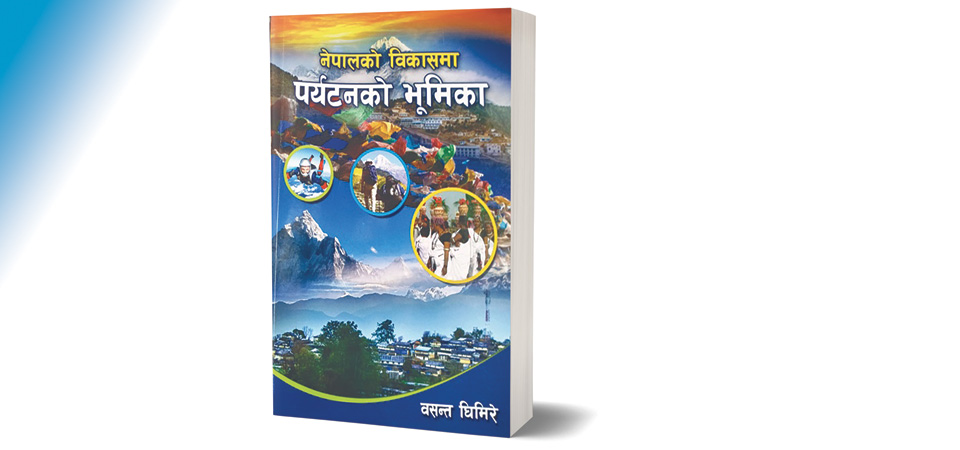Useful Publication For Tourism Study

Gandhi Raj Kafle
The word 'development' carries a multi-dimensional meaning. It is that word that has been beckoning us towards a condition where we have to march on, try to find the best meaning of life and do our best for betterment. The experiences of human civilization also tell us that 'development is an unending process. We keep doing, we sometimes even fall; but for sure we learn. In essence, this comprehensive process is called development.
So, to come to the context of the development of Nepal, we must see what experiences we have as a nation. The subject of economics has come to the mainstream these days. The economists of the country keep warning; they also praise the right approach and achievements and show development potential for the future. In this context, there are some high yielding sectors of development, which can’t be undermined if we want to achieve fast growth. Among such viable sectors, we have tourism which has been on focus for expansionary benefit. This potential is not only known at the policy level of the country but it has been increasingly recognized as a separate discipline of studies in the field of education also.
Against this backdrop, we have a book here that relates Nepal's development process exclusively from the point of view of tourism potential. The author of it is Basanta Ghimire, who has also four other economics-related books published to his credit previously.
The part prologue of the book, where we find comments of good wishes from learned scholars and the government officials of the economic field including the remarks of the then Minister of Culture, Tourism and Civil Aviation Yogesh Bhattarai, highlights the importance of tourism sectors for economic gains of the country. They have also commended the author because he has made a strenuous effort to collects updated tourism data and literature for his publication.
This 311-page book completes in eighteen chapters. The first chapter presents definitions of tourism and then gradually chapters like ‘Historical Background of Tourism’, ‘Tourism Development in Federal Set-up’, ‘Tourism Development in Periodical Plans’, ‘National Plans of Tourism Development until the beginning of the new 15th plan’, ‘Main Activities of Tourism sectors’, ‘Goal and Objectives of 2020 AD’ and ‘Tourism Policy’ are there in the book. The other chapters, which include fresh official policies, programs, schemes and guidelines, are also important for the readers of tourism. Furthermore, this book is a fresh publication and it serves updated statistics and literature of tourism to readers.
Ghimire’s this book should have been launched in the upbeat time of tourism if things have gone as planned by the government of Nepal.
But, it did not because the coronavirus Pandemic all of a sudden occurred and it still has been causing a huge blow to revive plans and programs of tourism sectors all over the world. At the national level, Nepal had an ambitious plan to bring in over two million tourists and preparations to do it were in full swing then. But, sometimes, it is the oft-quoted line of assumption 'other things remaining the same that becomes fully active and damages plans and programs by becoming ‘not same’. This time our country Nepal’s tourism suffered this way and now is the time of wait and see for revival, which may take time because the coronavirus has not yet been beaten completely.
Yet, the bright fact to note even in this dismal condition is tourism is one of the vibrant sectors of the Nepali economy. One or two year blow in business may be there, but having permanent potential is a separate thing of importance. There is tremendous scope to benefit from tourism in Nepal. Even Ghimire’s this book highlights what importance of tourism is there for the economic development of Nepal.
So, let’s pin new hopes for tourism and wait for good times; hopes and enthusiasm for economic development must not be abandoned. There are vaccines to beat the virus and they are being administered to people all over the world. Nepal is expecting help with vaccinations. The pandemic damaged the tourism sector, too, comes to normalcy with the end of coronavirus.
Against this backdrop, this book has its importance because it helps readers to know about tourism with new statistics and interpretations. There are chapters, which present what Nepal has done under its planned efforts to boost tourism and there is analysis on topics like the potential of 'Rural Tourism' and 'Home Stay' in this book.
In gist, the publication of this book has to be welcomed and the author deserves kudos for giving fresh reading material on tourism, which is a sector of hopes for the economic development of the country.
Recent News

Do not make expressions casting dout on election: EC
14 Apr, 2022
CM Bhatta says may New Year 2079 BS inspire positive thinking
14 Apr, 2022
Three new cases, 44 recoveries in 24 hours
14 Apr, 2022
689 climbers of 84 teams so far acquire permits for climbing various peaks this spring season
14 Apr, 2022
How the rising cost of living crisis is impacting Nepal
14 Apr, 2022
US military confirms an interstellar meteor collided with Earth
14 Apr, 2022
Valneva Covid vaccine approved for use in UK
14 Apr, 2022
Chair Prachanda highlights need of unity among Maoist, Communist forces
14 Apr, 2022
Ranbir Kapoor and Alia Bhatt: Bollywood toasts star couple on wedding
14 Apr, 2022
President Bhandari confers decorations (Photo Feature)
14 Apr, 2022










